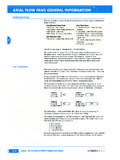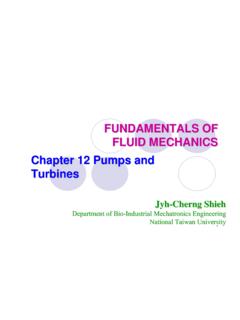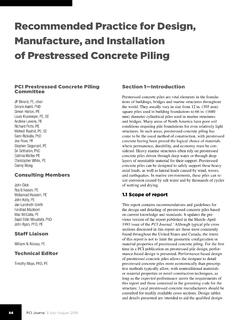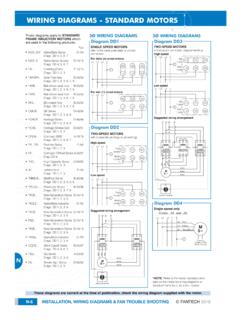Transcription of Figure 1 Quickand Easy Guide
1 F lu id Power | | | |. A Figure 1. Quick and EasytoGuide Hydraulic Pump Technology and Selection Of gear, piston and vane pumps, one type is not better than any other type in an absolute sense they simply are different, with individual strengths. T. he hydraulic pumps found in virtually all are fitted within a cylinder block and driven by an Rodney B. Erickson mobile and industrial applications today angled swash plate powered by the input shaft. As Senior Training Specialist use pistons, vanes, or gears to create the the swash plate rotates, the pistons reciprocate in Eaton Corp. pumping action that produces flow. Each their respective cylinder block bores to provide the method features individual characteristics that pumping action.
2 ( Figure 1 above). differentiate it from the others and make it suitable for axial -piston pumps are available with the a particular range of applications. input shaft and pistons arranged coaxially, or with the input shaft mounted at an angle to the piston Piston pumps bores. Bent axis pumps tend to be slightly more Piston pumps can have the pistons arranged in a radial volumetrically efficient for technical reasons, or axial fashion. Radial types tend to be specialized but they also tend to be slightly larger for a given for applications requiring very high power, while capacity and their shape can present packaging axial piston pumps are available in a wide range of difficulties in some applications.
3 Displacements and pressure capabilities that make A unique characteristic of a piston-type pump them suitable for many mobile and industrial tasks. is that the displacement can be changed simply axial -piston pumps consist of a set of pistons that by changing the angle of the swash plate. Any Reprinted from Design World for Eaton Corp., 2011 WTWH Media, Inc. Flu id Power | | | |. displacement between zero and maximum is easily achieved with relatively simple actuators to change the swash plate angle. Vane pumps The most commonly encountered vane-type pump generates flow using a set of vanes, which are free to move radially within a slotted rotor that rotates in an elliptical chamber. A typical configuration uses an elliptical cam ring with the rotor spinning within in a cylindrical housing and a pair of side plates to form the pumping chambers.
4 ( Figure 2) The changing volume of the cavity between adjacent vanes creates the pumping action as the rotor rotates. It is possible to vary the displacement of a vane- type pump, but this is not commonly done except for very specialized applications. The majority of Figure 2. the vane-type pumps used in industrial and mobile applications have a fixed displacement. Vane pumps can be hydraulically balanced, which greatly enhances efficiency. Some designs place the rotating group in a cartridge, which makes them very easy to repair. The entire rotating group is easily removed and replaced by simply removing the back cover, pulling out the old rotating cartridge and replacing it with a new one. Vane-type pumps are known for being very quiet in operation and producing very little vibration.
5 Gear pumps The simplest gear-type pump uses a pair of mating gears rotating in an oval chamber to produce flow. As the gears rotate, the changing size of the chambers created by the meshing and unmeshing of the teeth provides the pumping action. ( Figure 3). Another design uses an external rotating ring with internal gear teeth that mesh with an internal gear as it rotates. As the inner gear rotates, the tooth engagement creates chambers of diminishing size between the inlet and outlet positions to create flow. A more sophisticated variant of this principle is Figure 3. the gerotor pump, which has a non-concentric inner and outer rotor with different numbers of teeth. As the pair rotates, the changing volume of the space and are not generally economically repairable.
6 Between the rotors creates the pumping action. Replacing the meshing teeth of the gerotor pump Sweet spots with low-friction rolling elements produces a geroter Piston-type pumps have a very good service life, provided pump. contamination and heat are controlled. They also have the All gear-type pumps have a fixed displacement. highest pressure ratings, and the significant advantage of These pumps are relatively inexpensive compared variable displacement. This makes them the best choice for to piston and vane type pumps with similar applications where high efficiency and high power density displacements, but tend to wear out more quickly are important considerations. The ability to configure Reprinted from Design World for Eaton Corp.
7 , 2011 WTWH Media, Inc. Comparing pumps Flu id Power | | | |. Pressure Noise and Vibration piston-type pumps with both pressure sensing Piston pumps have the highest pressure Vane-type pumps are the quietest and most and load sensing capabilities is an important capabilities of the three technologies, up vibration-free followed by piston- and gear-type advantage, particularly in mobile applications. to 7250 psi (500 bar) for those in common pumps in that order. Vane-type pumps are widely used in use, and as high at 10,000 psi (690 bar) It is worth noting that piston pumps constant flow/constant pressure industrial for certain specialized units. Vane and gear can be significantly quieted by altering the applications because they are quiet and pumps are commonly limited to pressures up metering notch geometry on the valve plate.
8 Easily repaired. They also have the unique to about 4000 psi (275 bar). Doing so, however, reduces their efficiency. attribute of allowing a soft start because There is no free lunch. vane-type pumps typically do not achieve Input Speed full output at speeds below about 600 rpm. Piston pumps have the highest input speed Size and Weight This characteristic can significantly reduce capabilities. Gear pumps tend to the lightest for a given the starting current requirements of electric displacement, followed by vane and piston motors driving a vane-type pump which Power Density pumps in that order. Note also that all three extends motor life. Hydraulic power density is directly related to types can be ganged by stacking multiple Gear pumps are very common in operating pressure; the higher the pressure sections together.
9 This is more commonly done constant flow/constant pressure applications the greater the power density. Piston pumps with gear and vane pumps, but double piston on mobile equipment because of their low offer the highest power density with vane pumps are also available. cost and dirt tolerance. They are also widely and gear types following in that order. used as charge pumps to pressurize the inlets Fluid Compatibility of piston and vane pumps because of their Conversion Efficiency Piston and gear pumps tend to offer the excellent inlet vacuum tolerance. Like power density, the conversion ratio greatest range of fluid compatibilities. Note Other considerations of input power to output power is directly that is it often necessary to de-rate a pump Sizing a pump is not really dependent on related to operating pressure.
10 Piston pumps when it is used with non-petroleum fluids. which technology is chosen. In all cases, it offer the highest conversion ratio, followed Fluid compatibility depends on the type is best to start with the load and then work by vane and gear pumps in that order. The of seals, O-rings and materials used in the back through the system calculating losses at ability of piston and vane pumps to be construction of a pump. It's best to consult each point. Once the theoretical pressure and hydraulically balanced is also a factor in their the manufacturer before using any alternative flow characteristics are calculated, the input greater conversion efficiency. fluids. horsepower requirement can be determined.
















